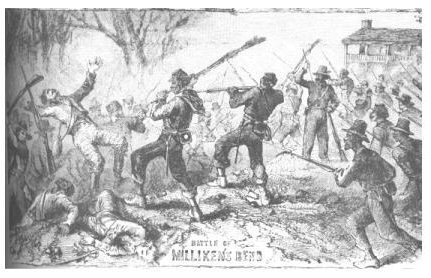The Gospel Army
|
The Battle of Milliken's Bend

On June 7, 1863 the Negroes demonstrated again at Millikens Bend that they would go the last mile of the way while on the other hand some white troops ran.
At Millikens Bend, some Illinois cavalrymen sneered, "A man ud be a dam fool to try to make soldiers out ah niggers. . . . Any one ough to Know a nigger wont fight: they'r running now. before they seen a reb. . . . We will show them how it is done if we find any of them." Several minutes later the Illinois horsemen raced past in retreat, pursued closely by the Confederates. The black company then rose up and delivered a volley that drove the Rebels back and saved the day. ( J. T. Glatthaar, Forged in Battle)
A captain in the USCT insisted, "It was a horrible fight' the worst I was ever engaged in, not even excepting Shiloh." He personally suffered two bayonnet wounds, and his men "met death coolly, bravely; not rashly did they expose themselves, but all were steady and obedient to orders." His young cook begged for a weapon when tht Confederates began their advance and fought valiantly, suffering a gunshot and two bayonnet wounds. no familiarity with a rifle, was found dead after the battle with his bayonet broken in three pieces.
"Their commander knew that because his troops were green, they would most likely shoot high in the excitement, and he ordered them to load their weapons but not to fire unless the muzzle was against a Confederate. Their primary weapon was the bayonet. Once they unleashed them, they struck with a fury, reviving the embattled Federals. One of his men, "Big Jack" Jackson, smashed so many people that his rifle butt shattered. In hand-to-hand fighting Jackson sustained multipible bayonet wounds but continued to struggle until a ball struck him down permanently. "
"For a few moments it seemed that the Federals might hold. Then, just as suddenly, things shifted when the Confederates seized a position on the extreme left portion of the levee and "poured a murderous enfilading fire along our line," according to Lieb. This stampeded the two companies of Iowans from the field, or, as Confederate General McColloch described it, "The white or true Yankee portion ran like whipped curs almost as soon as the charge was ordered." while the blacks resisted with "considerable obstinacy," yet they could not hold the levee."
" Several times the Confederates attempted to drive the black troops into the river, but they could not gain a toehold on the riverbank. After a long march, an early-morning advance, and several hours of vicious fighting, unanticipated by the Rebels, they were too exhausted to mount an effective charge, or as an officer in a black regiment crowed. Those negro bayonets had got on their nerves."
"The Battle of Milliken's Bend, one of the most desperate in the entire war, had ended.
In the 9th Louisiana Infantry (later the 5th U.S. Colored Heavy Artillery), nearly 45 percent of its men were killed or mortally wounded, the highest proportion in a single battle throughout the entire war, nearly 17 percent higher than figures for the next nearest regiment, the Minnesota Infantry at Gettysburg.
J. T. Glatthaar, Forged in Battle, p131-135
The Gospel Army Black History Group, contact: thegospelarmy@yahoo.com
Copyright © 2006 The Gospel Army Black History Group. All rights reserved.
Revised: 03/23/09.